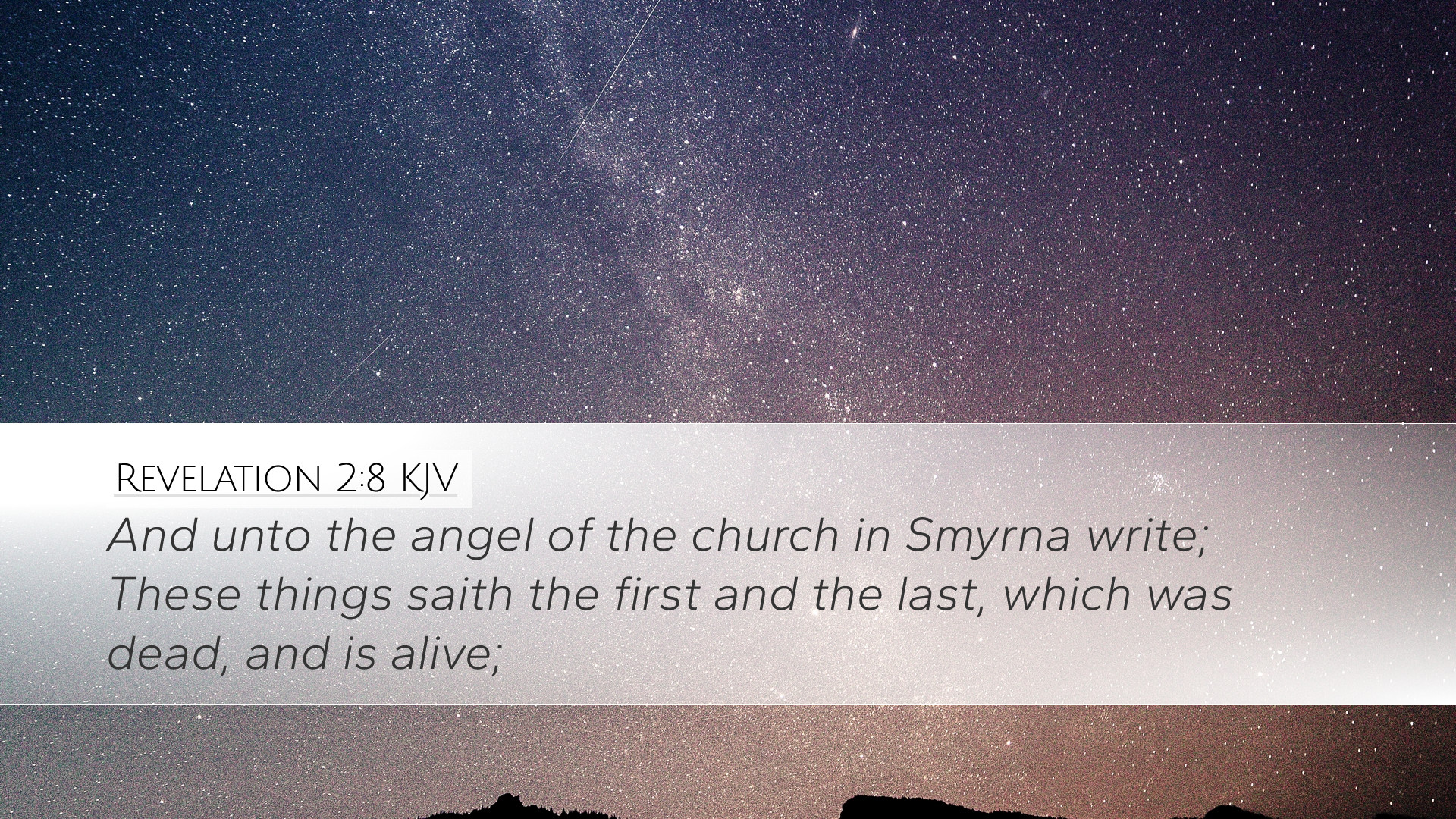Commentary on Revelation 2:8
Verse Text: "And unto the angel of the church in Smyrna write; These things saith the first and the last, which was dead, and is alive."
Introduction
The letter to the church in Smyrna represents one of the seven addresses to the early churches in Asia Minor, chronicled in the Book of Revelation. This particular church is praised for its endurance amid tribulations and poverty, and it stands as a reflection of unblemished faith in Christ, despite suffering and persecution. This commentary synthesizes insights from public domain sources, including Matthew Henry, Albert Barnes, and Adam Clarke, to examine the implications and teachings drawn from this verse.
Contextual Background
Smyrna, a prominent city known for its loyalty to Rome and its economic prosperity, was a hub of commerce. However, this prosperity often came at the cost of engaging in emperor worship, which posed significant challenges for Christians. The church in Smyrna faced slander and persecution from both the Jewish community and the Roman authorities, making the message of Jesus particularly poignant.
Analysis of Key Phrases
"And unto the angel of the church in Smyrna write;"
The reference to the "angel" typically implies a leader or a particular representative of the church. This phrase denotes that the message is not just for the congregation as a whole but specifically directed towards its leadership, underlining the importance of shepherding the flock amidst adversities.
"These things saith the first and the last;"
Albert Barnes emphasizes the significance of God identifying Himself as "the first and the last." This title reinforces the eternal nature of Christ, promoting the thought that He transcends time and is sovereign over all events. For Smyrna's suffering believers, this assertion provides consolation, as it reminds them that their Lord is not only present but also eternal, encompassing all aspects of existence.
"which was dead, and is alive"
This phrase encapsulates the core of the Christian faith—the death and resurrection of Christ. Matthew Henry highlights that Christ’s resurrection offers a profound assurance to the church; despite present struggles or fears of death, through Christ, believers can claim eternal life. This affirmation serves to inspire resilience in the face of persecution, as the ultimate victory over death has been attained through Him.
Thematic Insights
1. Endurance in Suffering
The Smyrnan church is acknowledged for its endurance, something that Adam Clarke vigorously emphasizes. The church’s challenges demonstrate a vital theme throughout scripture: perseverance in trials is a mark of genuine faith. Clarke points out that while temporal suffering is painful, it is often accompanied by spiritual growth and stability, drawing believers closer to the character of Christ.
2. The Reality of Persecution
Persecution defined the experience for many early Christians, and the church in Smyrna was no exception. Albert Barnes notes that even as the church faced outward afflictions, their spiritual state remained commendable. This encourages modern readers to remain steadfast despite social or familial ostracism for their faith.
3. The Sovereignty of Christ
Describing Christ as "the first and the last" serves as a profound reminder of His sovereignty over history and future events. Matthew Henry posits that this title not only establishes Christ’s authority but also comforts believers, affirming that their lives are held securely in His hands. This perspective provokes pastors to emphasize the importance of recognizing Jesus' supremacy in all teaching and guidance.
4. Encouragement to Remain Faithful
In the face of tribulation, the admonition to remain faithful is crucial. The letter to Smyrna encapsulates the essence of Christ’s pastoral care toward His followers. Adam Clarke underscores the necessity for Christians to mirror the steadfastness of this early church amidst contemporary challenges, reminding believers of the eternal rewards promised to those who persevere.
Application for Today’s Believers
1. Embracing Suffering as a Part of Faith
The church’s experience serves as a compelling illustration for believers today. In a world increasingly hostile to the Christian faith, drawing strength from the hope provided by Christ's resurrection is fundamental. The acknowledgment of suffering should not lead to despair but instead inspire faithful endurance.
2. Fostering Community Support
The Christians in Smyrna stood firm as a community against trials. The modern church would benefit greatly from a resurgence of communal support, encouraging congregants to bear each other’s burdens in faith and action, as outlined in Galatians 6:2.
3. Prioritizing the Eternal Over the Temporal
Believers are often tempted to focus on immediate comforts and prosperity. The reminder of Christ’s words encourages the church to prioritize eternal truths over temporary struggles, aiming for the crown of life promised in James 1:12.
4. Leadership in Faith
As the angel of the church represents church leadership, it is essential for pastors and leaders to embody the principles of humility, strength, and guidance. They are to reassure their communities that faith persists despite adversity, echoing Christ’s unwavering presence amongst them.
Conclusion
The exhortation to the church in Smyrna resonates powerfully with today's believers. Embracing trials and acknowledging the eternal nature of Christ serves as the foundation of faith that conquers despair. This commentary serves as a call to embrace both suffering and hope, ensuring that the promise of life through Christ remains central to the Christian narrative.


